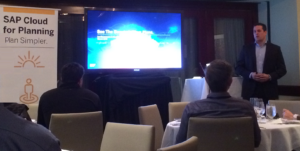
Last year, during the Enterprise Performance Management conference in Chicago, we were able to see Ivo Bauermann and Gerrit Kazmaier present SAP Cloud for Planning as part of the key note with a live demo of the application. At that time, the functionality looked easy enough for business users to take care of one of the most challenging processes within any organization, Financial Planning.
After interacting with the new application, we were able to verify for ourselves the simplicity within the application, the power behind it and visualize what could be coming. Thanks to our subject matter experts and the ease of use of the application, we were able to start building models and use some of the main functionalities within hours.
As experts on the Enterprise Performance Management field, SAP invited us to attend the presentation of SAP Cloud for Planning during the World Tour in San Francisco, CA. This was the perfect opportunity for us to ask some of the questions we foresee coming from the field based on our extensive experience with Financial Planning.
The session started with some very interesting remarks from Bill McNee and the research Saugatuck has done in terms of Cloud technology and what’s coming. Here are some of the main items on our list:
– Cloud technology is no longer in “Test Mode”. Most organizations are ready to embrace Cloud-based applications as success has been proven for many years now.
– The first wave of cloud apps was represented mainly by CRM solutions, followed by a second wave bringing Human Capital Management, Marketing, among others and the current wave has Finance as one of the main targets.
One of the points that was reiterated several times was the idea that the Cloud is not just to replicate what’s already being done on premises reducing the Cost of Ownership, but to take advantage of this technology and new frameworks and improve the way things have been done until now.
This is the idea of SAP Cloud for Planning. SAP has developed this application following their strategy of being the Cloud Company powered by HANA.
MS Excel limitations have been discussed over and over pointing some of the obvious issues such as multiple versions or the same information, collaboration issues, performance, etc. Many software vendors have developed applications that allow users to export results to or enter data from Excel and the main reason why that’s happening is that business users still feel very comfortable with it and they would like to keep using it.
Based on this we wanted to point out some of the key functionality that SAP Cloud for Planning offers:
1) Excel-like interface with Excel options such as formatting, copying and pasting, formulas, etc. to make sure users keep feeling comfortable with it and facilitate adoption.
2) Graphs: users can just select any cell in their existing reports and click on a button and the application will identify the best graph to visualize the information. Users can then modify it or pin it to a dashboard which is one of the most flexible dashboard engines people will see nowadays in any application, not just planning. As users drag and drop or resize items in their dashboards, all the charts automatically adapt making sure the most important information is always visible instead of shrinking it to a level where it’s not readable anymore.
3) Calendar management: tasks can be configured and monitored within the application in order to streamline the process. Each task can have an owner and it could be a different one for each area if the task is distributed throughout the organization. Deadlines, approvers and alerts can be set up to make sure everybody is on track.
4) Collaboration: at any point in the process, users can open an instant messaging window, within the application, and start a conversation sharing thoughts, reports or even tasks.
5) Mobility: You can get alerts and interact with the application from your mobile device.
6) HANA: last but not least you need to take in consideration the speed of the calculations. “What if” scenarios are key during this process. Creating a new scenario and adding or reducing 10% to a certain account in a matter of seconds highlighting all the fields that were impacted is just one of the many benefits offered.
The main configuration of the planning process for an organization has also been simplified, importing data is as easy as some of the latest application from SAP and it can be linked to existing BPC implementations to keep both synchronized.
If you have any questions about SAP Cloud for Planning don’t hesitate to contact us.
We want to thank again SAP for the invitation and we look forward to helping our customer improve their current processes with everything SAP Cloud for Planning has to offer along with the rest of the EPM applications we have in our portfolio.
For more information, click here
